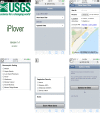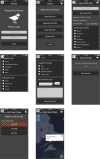Smartphone-Based Distributed Data Collection Enables Rapid Assessment of Shorebird Habitat Suitability
- PMID: 27828974
- PMCID: PMC5102412
- DOI: 10.1371/journal.pone.0164979
Smartphone-Based Distributed Data Collection Enables Rapid Assessment of Shorebird Habitat Suitability
Abstract
Understanding and managing dynamic coastal landscapes for beach-dependent species requires biological and geological data across the range of relevant environments and habitats. It is difficult to acquire such information; data often have limited focus due to resource constraints, are collected by non-specialists, or lack observational uniformity. We developed an open-source smartphone application called iPlover that addresses these difficulties in collecting biogeomorphic information at piping plover (Charadrius melodus) nest sites on coastal beaches. This paper describes iPlover development and evaluates data quality and utility following two years of collection (n = 1799 data points over 1500 km of coast between Maine and North Carolina, USA). We found strong agreement between field user and expert assessments and high model skill when data were used for habitat suitability prediction. Methods used here to develop and deploy a distributed data collection system have broad applicability to interdisciplinary environmental monitoring and modeling.
Conflict of interest statement
The authors have declared that no competing interests exist.
Figures






References
-
- Wong PP, Losada IJ, Gattuso JP, Hinkel J, Khattabi A, McInnes KL, et al. Coastal systems and low-lying areas In: Field CB, Barros VR, Dokken DJ, Mach KJ, Mastrandrea MD, Bilir TE, et al., editors. Climate Change 2014: Impacts, Adaptation, and Vulnerability Part A: Global and Sectoral Aspects Contribution of Working Group II to the Fifth Assessment Report of the Intergovernmental Panel of Climate Change. Cambridge, United Kingdom and New York, NY, USA: Cambridge University Press; 2014. p. 361–409.
-
- Moser SC, Davidson MA, Kirshen P, Mulvaney P, Murley JF, Neumann JE, et al. Coastal zone development and ecosystems In: Melillo JM, Richmond TC, Yohe GW, editors. Climate Change Impacts in the United States: The Third National Climate Assessment. Washington, D.C.: U.S. Global Change Research Program; 2014. p. 579–618.
-
- U.S. Fish and Wildlife Service. Endangered and threatened wildlife and plants: determination of endangered and threatened status for the piping plover: final rule. Federal Register. 1985;50(238):50726–34.
-
- U.S. Fish and Wildlife Service. Preliminary 2012 Atlantic Coast Piping plover abundance and productivity estimates 2013 [15 September 2015]. Available from: http://www.fws.gov/northeast/pipingplover/pdf/preliminary2012_18April201....
MeSH terms
LinkOut - more resources
Full Text Sources
Other Literature Sources

